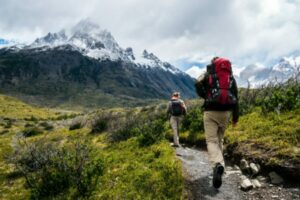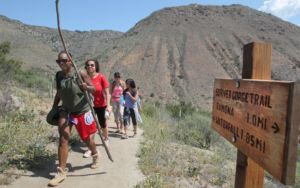There’s nothing like hiking. The complete freedom, fresh air, and pristine wilderness is why we all hit the trails for days on end.
As much as we want to keep going, we can’t! Sooner or later, we’re going to run out of juice. But when? How many miles can you actually hike in a day?
In this post, we’ll look at the mileage that an average person has and what influences these numbers.
So How Many Miles Can You Hike in a Day?
A person of average fitness can cover 8 to 12 miles a day with a beginner to intermediate level of hiking experience. However, experienced hikers with stellar fitness can cover 12 to 16 miles a day! And some thru-hikers on the Pacific Crest Trail and the Appalachian Trail have been known to clock between 16 and 20 miles a day after months of being on the trail. The average hiking speed is about two to three miles a day, and on long trails like the PCT and the AT, the speed can be increased to three to four miles.
If you’re just getting started hiking, it isn’t recommended that you push yourself too far in the beginning as you might strain or hurt yourself. Experienced hikers in tip-top shape that hike 16+ miles a day only do so after careful preparation and loads of training.
What Factors Affect How Many Miles You Can Hike?

Many factors like the terrain, weather, footing, crowd, and gear will significantly affect your miles.
The Terrain
The terrain and physical features along the trail you’ve chosen are crucial to the distance you can cover. Walking on a flat, soft trail is one thing, but scrambling up loose, rocky scree is a whole different ballgame. Is your trail going wind through a forest, or are you going to have a steep uphill climb up loose rock, roots, and boulders?
Of course, a nice forest hike will be less strenuous and mentally taxing. Just place one foot in front of another and enjoy the lush surroundings! When scrambling over boulders and loose rock, though, you’ll constantly have to be on the alert and think about your foot placement. You’ll barely have the chance to look around and will have to be looking at the ground to keep from face planting!
While this might not sound like a big deal, the truth is that it takes a mental toll as well as a physical one, and you might just find yourself surprisingly tired after a couple of hours. Some hikers will only be able to hike around 1 to 2 miles if the terrain is very inclined. And of course, it usually means you’ll be able to go further and faster in terms of distance when you take on forest trails.
Most maintained trails will have extensive information of the difficulty and terrain, so ask the management of the area or check online first before you head out. That way you can choose something that would be ideal for your physical and mental capabilities.
Your Fitness and Experience Levels

Another crucial factor that you’ll do well to keep in mind before you head out is also your fitness and experience levels. These will determine how much you can pace yourself as you hike the trail.
Be honest with yourself! There’s no point struggling along a trail if you’ve bitten off more than you can chew. For people with moderate to high fitness levels, you might make up for the lack of experience and hike more miles than those who rarely exercise. Experience counts for heaps, especially when it comes to rough terrain. Those with extensive experience might still hike at the same pace as an inexperienced hiker with superior fitness.
Overall, it is a combination of experience and fitness. You might have experience in hiking, but if you’re not currently at the level of fitness that allows you to perform as before, you won’t go as fast as you used to.
The Weather
The weather during a hike significantly affects how many miles you’ll be hiking that day. Although this is something that’s completely out of your control, you can always check the weather forecast (and you should!). Some weather conditions that could hinder your hike are torrential rain and high winds. Some of these conditions you shouldn’t be hiking in, either! But even just a little rain

can slow your progress.
Always be prepared before you go on a hike, and check for a more pleasant day. If the weather suddenly turns bad, you might think about rescheduling your hike or be prepared to do it drenched to the core.
Heat is also a dangerous situation, too. It is one thing hiking on a pleasant spring or fall day, but another trying to do the Grand Canyon in July or August. Temperatures regularly reach above 90 F / 32 C, and not only will this completely drain you, but it could also get dangerous. Heat exhaustion afflicts hikers each year, especially in summer. You’ll also need to carry way more water, which means you’re lugging around a heavier pack and spending loads more energy. Unless you are used to severe heat and know how to keep yourself hydrated, you might want to avoid extensive hiking during the hottest times of the year.
Your Footing
In addition to terrain, footing refers to the conditions of the trail throughout the year and how each condition affects your footing. For example, hiking a hard-packed, dry trail in the summer might be ideal. However, two or three months earlier and that same trail might still have snow on it that will hamper you. It might also have snowmelt and be muddy; you really don’t want to get those hiking boots caked with mud!
While summers are hotter, they can be way drier, especially at altitude. You can always check the trail conditions with the ranger station or anyone else that might be maintaining the trail.
Spring is the tricky one. Trails might still be snow-covered, or muddy. Summer and fall are usually safe bets, but you’ll need to watch the weather.
Sometimes you might find yourself “scrambling” over rocky stretches or boulders on the trail. Scrambling is a cross between hiking and mountain climbing, but without the serious vertical. You don’t need to be a mountain climber to scramble, but it definitely slows you down. A tip – have leather gloves along so you can brace yourself on sharp rocks without worry.
The Crowds

How crowded the trail is will also determine your speed. Having an empty forest to play in is completely different than hiking a popular trail and being stuck behind someone slower on a narrow section, or having to constantly step aside to let someone pass. Hiking on a weekend day on the Herman Gulch Trail, for example, will have way more people than thru-hiking on the Superior Hiking Trail where you may barely see a person per day.
While crowded trails are usually gorgeous and popular for a reason, you might want to avoid them, especially during peak periods like weekends and holidays. Hitting the lesser-known trails first will mean you have all that nature to yourself. Keep the popular trails for off-peak days like in the middle of the day on a weekday and try your luck then.
Parking lots are a good indicator of how many people are on the trail. If the parking lot is full or spilled into the overflow, you might want to rethink your choice of the trail for the day!
Altitude
Don’t underestimate the impact of altitude, especially if you are coming from sea level. “High altitude” technically starts at 4,900 feet (1,500 meters) above sea level, but in most people the change can really be felt at around 7,000 feet. Of course, all these are dependent on individual factors like physical fitness and respiratory health. Once you hit about 11,500 feet, you’re definitely going to feel the difference! But, on the other hand, if you live at elevation, the change might not be that obvious.
I know some people who live at sea level and can feel the altitude at just 2,500 or 3,000 feet!
If you go straight from sea level to 10,000 feet and then start to hike up a 14-er, you might have trouble breathing and it can take you a while to the thinner air and decreased oxygen.
And as we know, the higher the altitude, the less oxygen will be available. This will affect your energy levels, which in turn determine how far you can hike. Places with high elevations will tire you out faster compared to those in nice, lower altitudes such as by the beach. Higher altitude sometimes also means the environment is more intense.
Your Gear

Last but not least, what you bring along with you will also determine how far you can hike. Try to be more flexible and practical by bringing what’s only necessary because heavier packs will wear you out faster, and you’ll be gassed out lugging your pack around.
Shoes are also of utmost importance. Make sure you have decent support, protection from rocks, and good traction so you don’t slip ‘n slide around muddy or wet terrain. Finding the right hiking boot or shoe is something you don’t want to rush.
For some, hiking is a peaceful, leisurely activity that you enjoy happily and comfortably. It is the time to be at one with nature and appreciate the beautiful world we live in.
And for others, it is pushing themselves to a breaking point and testing the boundaries of what they can do.
Above it all, be safe! Just because you’ve hiked 20 miles a day once before doesn’t mean you have to do it all the time. Enjoy yourself, and if you aren’t smiling, you aren’t doing it right!







